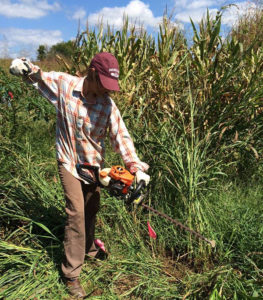My name is Alyssa and I am a first year PhD student at the University of Arizona. We
know that species diversity has profound effects on Earth’s ecosystems, but the effects
of intraspecific diversity remains a frontier to be explored. Therefore, I am interested
broadly in the ecological importance of within-species diversity and the implications this
might have on ecosystem processes, community composition, adaptive potential, and
species interactions. My work aims to shed light on this cryptic component of Earth’s
biodiversity (within species), combining aspects of biogeography, ecology, evolution,
ecosystem science, and genomics.
I received a master’s degree in invasive plant ecology from Virginia Tech in 2017, and
my research there focused on understanding how adaptive ploidy plasticity
(endoreduplication) and corresponding variation in growth responses influence how a
global invader (Johnsongrass) deals with different forms of stress. By evaluating these
responses in genotypes across Johnsongrasses’s native and non-native ranges, such a
biogeographic approach allowed us to assess intraspecific variation in stress response
in way that I hope to apply in future studies assessing variation within other species
variation.
I am thrilled about this trip to Peru and this class (for many reasons!) but primarily for
the opportunity to learn in detail about methodology used to study trait variation. I am
new to this field, but I am excited to apply this methodology to study trait variation within
species. Furthermore, these interests the trait-based ramifications of intraspecific
diversity overlap to some degree with my interests in invasive species. Invasive species
often “break the rules”, frequently growing much larger in their non-native ranges, even
to the point of dramatically increasing landscape productivity. Again, this is the same
species in the native range and the non-native ranges, just showing a great deal of
intraspecific variation. Thus, I would like consider range-type comparisons of how this
kind intraspecific diversity affects allometric relationships. For example, if conspecifics
in the non-native ranges are growing much larger than in the native range, might this
correspond with interesting allometric differences? I am extremely excited for the
collaborative environment this course promises and the opportunity to learn from and
share science with this group!

I try not to think too much about other’s perspectives on global climate change. My goal
as a researcher and scientist-in- training is help understand and inform others (through
teaching and publication) how ecosystems respond to variable environmental factors. I
am not going to pretend that my work will have an everlasting signature or alter the
opinions others. I can only hope that my work will help other researchers with similar
goals help find the elusive answers as to how and why our world will change under the
looming pressures of anthropogenically driven climate change and disturbance.